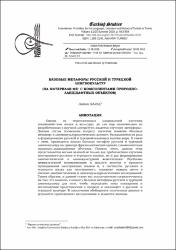Basıc Metaphors of Russıan and Turkısh Lınguocultures (Based on Pu2 Components of Natural-Landscape Objects)
Abstract
The study of ‘basic metaphors’ is one of the upcoming trades in studying the interaction between language and culture. This trend, however, has not yet been developed enough in the academic literature. This article is devoted to the concept of the “basic metaphors” in the linguo-cultural aspect and their role in the formation of the Russian and Turkish linguistic views of the World. Thereby, the research of the basic metaphors in Russian and Turkish linguocultures is carried out through the analysis of phraseological units including environmental objects. In addition, this subject is very important not only for the learning of Russian and Turkish languages, but also for the building of linguocultural competence. Problems of intercultural communication and dialogue between cultures in foreign language learning and, in particular, in studying Russian and Turkish languages, play an important role in the system of linguistic and linguo-culturological research. Thus, we focused on identification and description of the basic metaphors of Russian and Turkish linguocultures in order to identify similarities and distinctions in conceptualization of the nature and landscape in the Russian and Turkish cultures. In the final part of the paper the results are summarized and the main conclusions are given The study of ‘basic metaphors’ is one of the upcoming trades in studying the interaction between language and culture. This trend, however, has not yet been developed enough in the academic literature. This article is devoted to the concept of the “basic metaphors” in the linguo-cultural aspect and their role in the formation of the Russian and Turkish linguistic views of the World. Thereby, the research of the basic metaphors in Russian and Turkish linguocultures is carried out through the analysis of phraseological units including environmental objects. In addition, this subject is very important not only for the learning of Russian and Turkish languages, but also for the building of linguocultural competence. Problems of intercultural communication and dialogue between cultures in foreign language learning and, in particular, in studying Russian and Turkish languages, play an important role in the system of linguistic and linguo-culturological research. Thus, we focused on identification and description of the basic metaphors of Russian and Turkish linguocultures in order to identify similarities and distinctions in conceptualization of the nature and landscape in the Russian and Turkish cultures. In the final part of the paper the results are summarized and the main conclusions are given
Source
Turkish Studies (Elektronik)Volume
11Issue
20URI
http://www.trdizin.gov.tr/publication/paper/detail/TWpjeU9ESTNOdz09https://hdl.handle.net/11421/14090


















